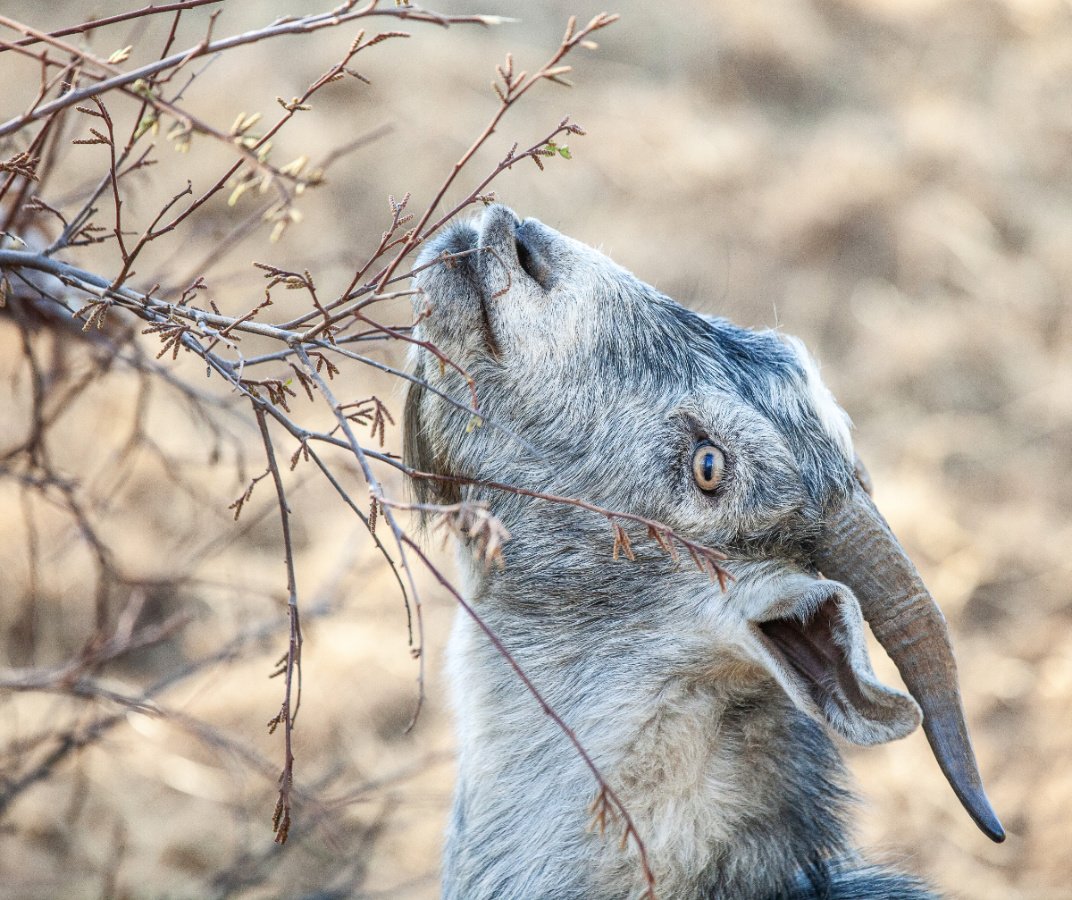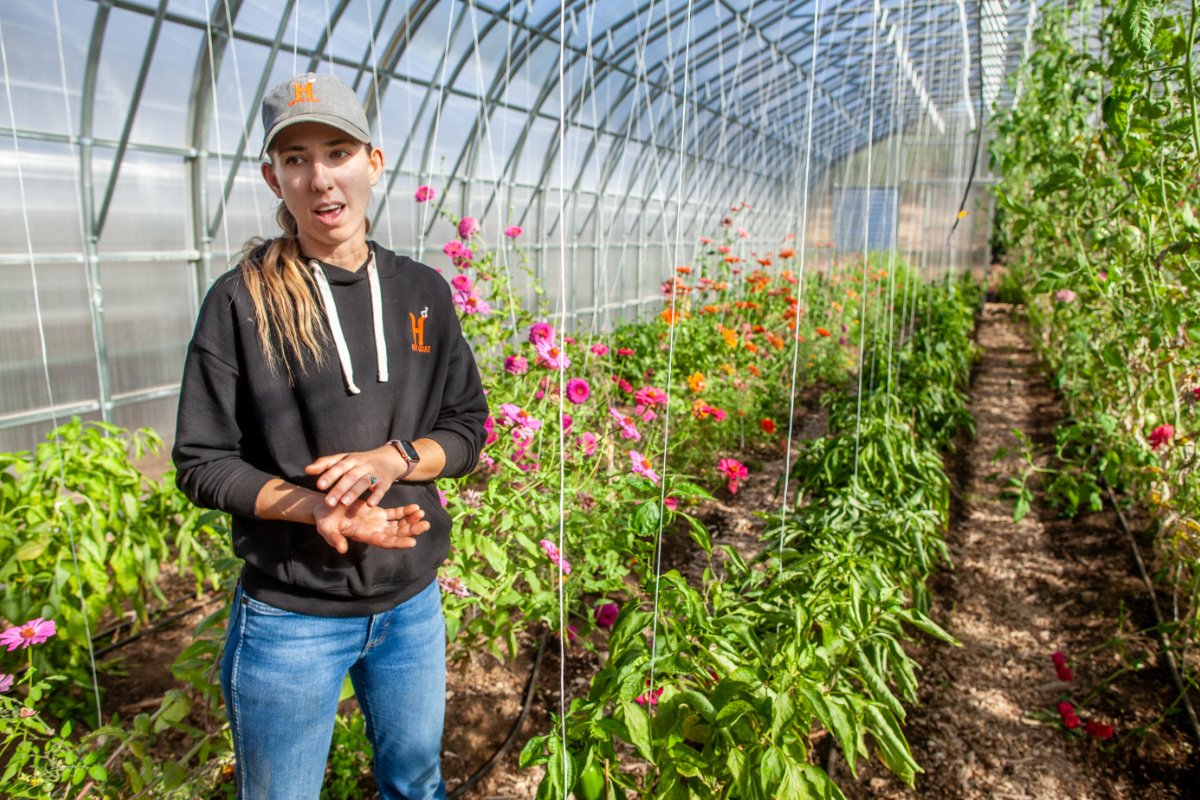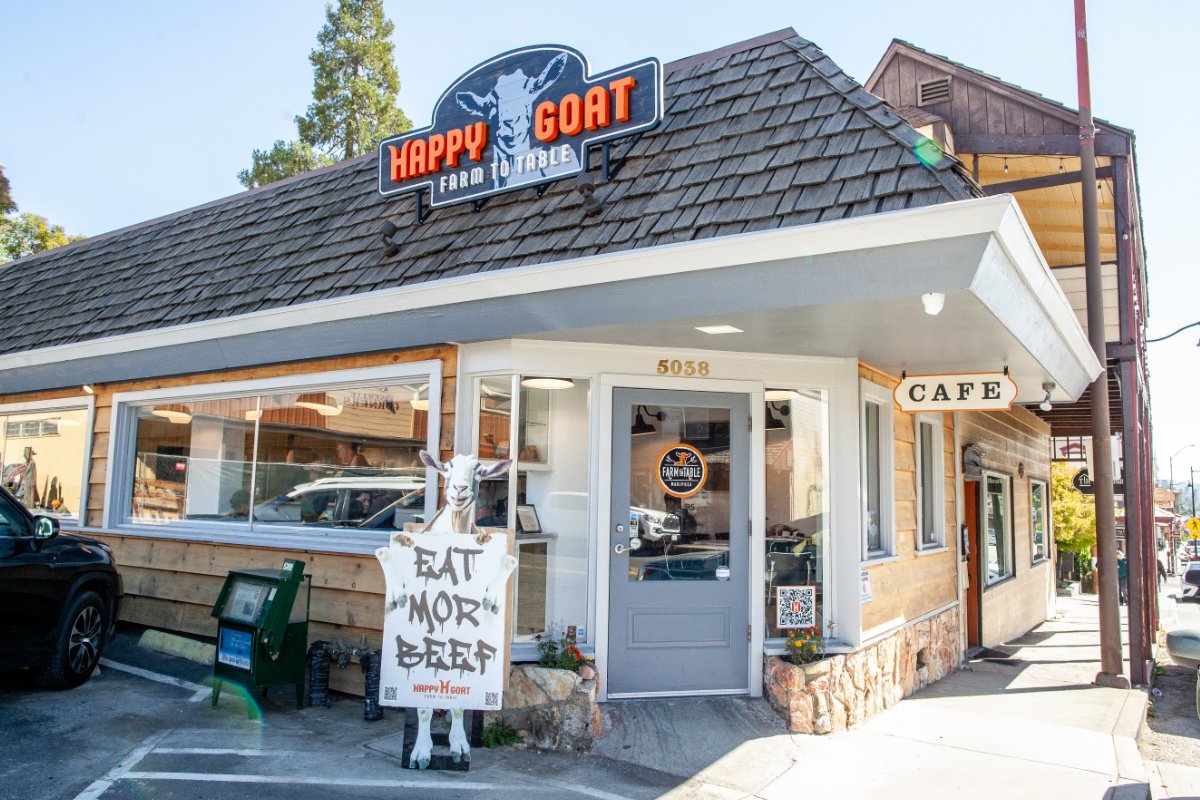A California nonprofit builds community through goat grazing to reduce wildfire risk, farm-to-school programs, and more.

A California nonprofit builds community through goat grazing to reduce wildfire risk, farm-to-school programs, and more.
October 2, 2024

A herd of goats graze on dry brush, grass, and low-hanging tree branches on a hillside property outside of Mariposa, California. The goats are part of Happy Goat of Mariposa which provides the vegetation-clearing creatures to landowners to reduce wildfire risk. Photo by Craig Kohlruss.
On a sunny California day, Ricky Bobby the goat chomps across a hillside with the speed and pizazz of his NASCAR driver namesake from Talladega Nights.
Along with his fellow herd members, all employed by the nonprofit Happy Goat to reduce wildfire risks, Ricky Bobby is doing what he does best, gobbling up weeds, shrubs, and leaves from low-hanging branches. No plant appears to be too much of a challenge, including poison oak and spiky live-oak leaves. He and 100 caprine teammates can clear about an acre a day.
“I really think that this is a hope of the future—organizations like them who really care about the environment, who care about the welfare of the Earth, who care about the climate and the quality of life for people,” says Carole Beckham, who hired Happy Goat to graze a portion of her 23-acre residential property in the Sierra Nevada. “With all the big fires we’ve had over the last several years, it’s really impacted the quality of life for a lot of people. It seems like Mariposa County has been in PTSD every year.”

A goat nips on a branch on a hillside property outside of Mariposa. The goats are part of Happy Goat of Mariposa, California which provides the vegetation-clearing creatures to landowners to reduce wildfire risk. Photo by Craig Kohlruss.
Founded in 2020, Happy Goat farm sits on a 2,000-acre property in Mariposa County, near Yosemite National Park. The organization’s Goats for Good program leases out its grazing herd to nearby landowners in the Sierra Nevada at a reduced price, and hopes to make the service free of charge for some residents via a lottery. The farm also teaches local students about agriculture and conservation—and donates much of the fruits and vegetables it grows to people in need.
“It’s a crazy twisted road that I went down that ended up here in this magical place,” says John Cahalin, one of three Happy Goat co-founders (and the one who named Ricky Bobby).
Ricky Bobby is doing what he does best, gobbling up weeds, shrubs, and leaves from low-hanging branches.
The San Diego transplant came to Mariposa several years ago in search of land for an off-road vehicle rally school, but his vision for the property changed after he met Jesse Fouch, a sixth-generation farmer, rancher, and owner of Fouch Farms. As Cahalin learned more about his new home, he decided farming was a better fit—something intrinsic to Mariposa and good for tourists, too. Fouch joined him as one of three co-founders of Happy Goat.
Cahalin wanted goats to be a big part of the farm. “Goats are mischievous, they’re affectionate, and they’re just the most beautiful animals to me,” Cahalin says. “They make me laugh every time I see my favorite ones.”

Happy Goat co-founder John Cahalin holds a baby goat on the nonprofit’s farm in the Sierra Nevada foothill community of Mariposa. Photo by Craig Kohlruss.
Lacey Sharp, Happy Goat’s daily operations manager, among other things, launched the organization’s Goats for Good grazing program over a year and a half ago, and since then, the goats have cleared more than 40 properties in the Mariposa area. That amounts to approximately 200 acres in addition to the 220 acres the goats take on each year back at the farm.
Sharp runs a holistic program that puts the health of all involved—the animals, the landscape, and the humans seeking fewer wildfire risks—at the center of every decision. The goats spend a limited amount of time in each section of a property, managed by a moveable fence and the watchful eyes of a couple of shepherds and dogs. Sharp is careful not to let the goats overgraze, which can compact soil.
“We’re very in tune with the climate around us and the land we’re working on,” she says. Sharp is also a veterinary technician, and runs a small cattle business influenced by the Texas ranch where she grew up.

Happy Goat grazing director Lacey Sharp pets Ricky Bobby, one of the many goats that Happy Goat uses for Sierra foothill wildfire mitigation. Photo by Craig Kohlruss.
The nonprofit has around 450 goats—primarily the cashmere type—with plans to grow the herd to nearly 3,000. About 100 billy goats currently handle the grazing contracts, while the nannies grow the herd back at the farm. Their kids enjoy a happy youth that includes scrambling all over a massive jungle gym called the “Goatnasium.”
The goats are part of a growing trend of using livestock to mitigate wildfire risks across the West. That need is acute in California’s Sierra region, where catastrophic fire presents an unprecedented challenge. More than 880,000 people live in this mountainous stretch of the state, according to the California Wildfire & Forest Resilience Task Force.
Mariposa County, where 16 percent of the population lives below the poverty line, is still recovering from the particularly devastating Oak Fire, an arson-caused blaze that leveled 127 homes and 66 outbuildings in 2022. In July, a new threat, the 908-acre French Fire—caused by a lawn mower that ignited dry grass—burned dangerously close to Mariposa’s historic main street and destroyed or damaged 18 structures.
The use of goats for targeted grazing is becoming more popular statewide as it is consistent with increasing the protection of people, structures, and communities
“The use of goats for targeted grazing is becoming more popular statewide as it is consistent with increasing the protection of people, structures, and communities,” says Kara Garrett, coordinator of Cal Fire’s Community Risk Reduction Program. “Many have found grazing to be an effective tool. Not only do [the goats] help clear annual vegetation, but they also browse up trees and reduce fuel loads, helping property owners with their fuel reduction.”
Cal Fire doesn’t hold contracts specifically for grazing, Garrett says, but 18 of the Wildfire Prevention Grants it awarded for 2022-2023 went to projects that included grazing. “Lawn mowers, weed eaters, chainsaws, tractors, and trimmers can all spark a wildland fire if used during the wrong time of year,” Garrett says. “And with work still left to be done across California, the grazing goats are a safe alternative to help maintain vegetation.”

Happy Goat co-founder John Cahalin, in lime green, tosses out feed to a mob of goats as they climb over him and some fellow Happy Goat supporters during a break in the daily work effort. Photo by Craig Kohlruss.
Nearly a third of all acres treated in fuel-reduction projects by the Bureau of Land Management (BLM) in California utilize grazing, which includes goats, says Sarah Denos, a spokesperson for the BLM in California. Acres grazed for fire mitigation through the agency more than doubled between 2018 and 2022, Denos says. BLM data shows a spike from about 5,400 acres in the state to 18,000 acres during that period.
Goats can be used in lieu of herbicides to target invasive plants in a way that helps restore balance to the ecosystem, including by adding nutrients back to the soil through their waste, Denos says. Additionally, goats can navigate steep, rugged terrain where machines aren’t practical, she adds.
There are drawbacks, of course. A herd of goats, if not properly monitored, can mow through a lot of land, eating up everything.
But if they’re well guided, goats can also be an appropriate tool in locations requiring a “lighter touch,” such as sensitive cultural sites, says Mark Thibideau, a spokesperson for the U.S. Forest Service Pacific Southwest Region. Beyond general grazing permits, which the Forest Service has issued since its inception, Thibideau says that last year his region used livestock to graze 4,544 acres specifically to mitigate wildfire.
In rural Mariposa County, where many large, historic ranches have been replaced by smaller residential parcels that can easily get overgrown, Happy Goat provides help. Goats’ love of leaves means they create extra clearance between the ground and low-hanging branches, which helps prevent fire from jumping into the tree canopy. Happy Goat’s humans also assist by doing some pruning to ensure that clearance extends to six vertical feet.
Other goat operations in California include those led by the Ojai Valley Fire Safe Council, City Grazing in San Francisco, and numerous Sonoma County grazing cooperatives. “They’re more sustainable—they have less impact to the environment,” one Southern California Edison worker told The Fresno Bee about using goats from Chasin Goat Grazing for vegetation management beneath power lines in the Sierra. “And from a sociological perspective, people can get behind goats.” A free, online search tool and map called match.graze, launched by the University of California Cooperative Extension and previously reported on by Civil Eats, displays many more California herds for hire.
“In California every year, everyone gets nervous for wildfire season, and rightfully so,” says entrepreneur Willie Morris, the third Happy Goat co-founder. “But the fact that we can take goats—which to me are like such silly, funny creatures—and they can be the frontline of fire prevention, and they can get to places we could never really do with machinery, to me, it’s just a no-brainer.”

Jessica Segale talks about her work as Happy Goat’s greenhouse manager and produce grown on their regenerative farm in the Sierra Nevada foothill community of Mariposa, California. Segale is also director of Happy Goat’s farm-to-school program. Photo by Craig Kohlruss.
Grazing is just one of the programs that makes Happy Goat a boon to its community.
Happy Goat’s farm-to-school program connected with around 1,400 students last year from several local schools, supported by federal and state grants, for hands-on learning experiences in agriculture and conservation. That outreach continues, and the farm recently became a new contracted provider of produce for Mariposa County Unified School District. Happy Goat also helps recycle food waste from local school cafeterias, using it to create compost for small school gardens and its farm.
Meanwhile, Happy Goat is working toward regenerative farm certification from the Savory Institute, a nonprofit focused on restoring grasslands through holistic management. “We’re building topsoil, we’re sequestering carbon, we’re improving the forage, the trees, the grasses,” says Fouch, who designed the farm and is also an associate educator with the Savory Institute. “We monitor insect populations, the birds, the bees—everything.”
Goats can be used in lieu of herbicides to target invasive plants in a way that helps restore balance to the ecosystem, including by adding nutrients back to the soil through their waste.
The farm grows a wide variety of fruits and vegetables by intercropping them, choosing varieties that are “happy around each other,” says Jessica Segale, director of its farm-to-school program. This classic organic farming technique promotes biodiversity and can also reduce pests. Also, plants are sprayed with natural compost extracts instead of harmful chemicals.
Happy Goat donates much of its produce to food banks. It gave away 4,400 pounds of produce last year—more than a third of all it grew—and plans to double that number. Beyond goats, other animals on its farm include chickens for eggs, sheep, pigs, ducks, guineafowl, and a goose. None are used for meat.
The organization also has a goat therapy program that provides stress relief for humans—including some college students who got to enjoy the animals at the University of California, Merced, campus during finals week.
Funding for Happy Goat’s philanthropic efforts comes from related enterprises, like its for-profit diner, Happy Goat Farm to Table, which opened last fall in the town of Mariposa just down the road. Happy Goat was also awarded a rural development grant from the United States Department of Agriculture last year to research the feasibility of using the goats’ hair for cashmere production, which is limited in the United States.

Happy Goat Farm to Table diner in downtown Mariposa offers meals with ingredients from the nearby Happy Goat farm. The for-profit diner opened in the fall of 2023 and its proceeds support the work of nonprofit Happy Goat. Photo by Craig Kohlruss.
Happy Goat intends to keep growing, all with the help of Ricky Bobby and the rest of the goats.
“They have limitless land to range on.” Sharp says. “They never run out of feed. They are not put into a holding pen where they spend 24/7 on a dry lot. We literally use them for what they were created for, and that’s what makes them so happy—and it’s what makes us happy.”

October 9, 2024
In this week’s Field Report, MAHA lands on Capitol Hill, climate-friendly farm funding, and more.
October 2, 2024

October 1, 2024

October 1, 2024

September 25, 2024

September 24, 2024

Like the story?
Join the conversation.